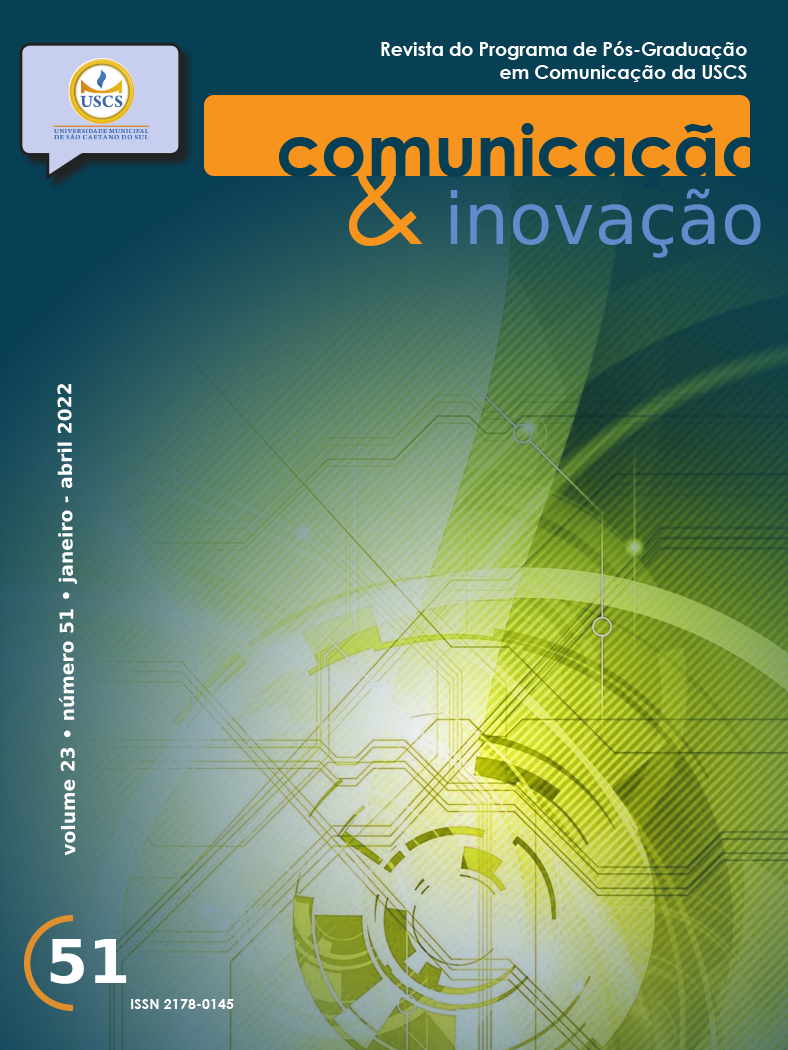Mobilidades urbanas, redes digitais e ocupação da cidade: um estudo sobre os sistemas de bicicletas e patinetes compartilhados sem estações em São Paulo
DOI:
https://doi.org/10.13037/ci.vol23n51.8176Keywords:
Mobility Apps, Urban mobilities, Location-based media.Abstract
The proliferation of mobile technology and location-based media has transformed countless everyday practices, including practices linked to urban mobilities. Based on this context, the objective of the research is to investigate the impact of dockless bike and e-scooter sharing systems in the city of São Paulo. The techniques and methodological procedures used are use of data extracted from secondary sources, semi-structured interviews with users of these systems, analysis of images posted by users of these systems on the social network Instagram. The first results indicate that the investigated systems act in the occupation and resignification of public space in São Paulo by suggesting an inflection in the modalities of displacement through the city. However, with the Covid-19 pandemic, the socio-spatial and economic limitations and implications of these systems were equally highlighted, so that the empirical analysis of the phenomenon culminates in the analysis of its emergence, implementation and interruption.
Downloads
References
BASTOS, A. F. S.; MELLO, S. C. B. Paulista aberta: significados da avenida símbolo da cidade de São Paulo. Urbana: Revista Eletrônica do Centro Interdisciplinar de Estudos sobre a Cidade, vol. 9, n. 3, p. 521-539, 2017.
BENEDINI, D. J. Bicicletas próprias e compartilhadas na cidade de São Paulo: perfil dos usuários e características das viagens. 2018. Dissertação (Mestrado em Engenharia de Transportes) - Escola Politécnica, Universidade de São Paulo, São Paulo, 2018.
BESLAY, L.; HAKALA, H. Digital territory: Bubbles. In: KIDD, P. T. (Org.). European visions for the knowledge era. Grã-Bretanha: Cheshire Henbury, 2007, p. 69-78.
CAETANO, A. Práticas fotográficas, experiências identitárias: A fotografia privada nos processos de (re)construção das identidades. Sociologia, Problemas e Práticas, N. 55, p. 69- 89, 2007.
CENTRO BRASILEIRO DE ANÁLISE E PLANEJAMENTO - CEBRAP. Impacto social do uso da bicicleta em São Paulo. São Paulo: Cebrap, 2018.
COMPANHIA DE ENGENHARIA DE TRÁFEGO - CET-SP. Plano Cicloviário do município de São Paulo. São Paulo: CET, 2018.
DUARTE, J. Entrevista em profundidade. In: DUARTE, J.; BARROS, A. (Org.). Métodos e técnicas de pesquisa em comunicação. São Paulo: Atlas, 2005. p. 62–83.
FARMAN, J. Mobile interface theory: Embodied space and locative media. New York and London: Routledge, 2013.
PROCON - FUNDAÇÃO DE PROTEÇÃO E DEFESA DO CONSUMIDOR, Relatório Pesquisa Patinete Elétrico. São Paulo: Procon-SP, 2019.
GREENFIELD, A. Everyware: the dawning age of ubiquitous computing. Berkeley, CA: New Riders, 2006.
HARVEY, D. The right to the city. The City Reader, v. 6, p. 23-40, 2008.
HANSMANN, U.; MERK, L.; NICKLOUS, M. S., et al. Pervasive computing: The mobile world. Berlin; New York: Springer, 2003.
KELLERMAN, A. Personal mobilities. London; New York: Routledge, Taylor & Francis Group, 2006.
KERLINGER, F. N. Metodologia da pesquisa em ciências sociais: um tratamento conceitual. São Paulo: Epu, 2003.
LANGLEY, P.; LEYSHON, A. Platform capitalism: the intermediation and capitalisation of digital economic circulation. Finance and society, v. 3, n. 1, p. 11-31, 2017.
LEFEBVRE, H. Le droit à la ville. Paris: Anthropos, 1972.
LEMOS, A. Cultura da Mobilidade. Revista FAMECOS. n. 40, p. 28-35, 2009.
LEMOS, A. Celulares, funções pós-midiáticas, cidade e mobilidade. Revista Brasileira de Gestão Urbana, v. 2, n. 2, p. 155–166, 2010.
LEMOS, A. Realidad aumentada. Narrativa y médios de georreferencia. Versão em português do artigo. In Sánchez, Amaranta (org). Móbile. Reflexión y experimentatión en torno a los médios locativos en el arte contemporâneo en México., Consejo Nacional para La Cultura y lãs Artes / Centro Multimedia – CENART, México, DF, 2013., p. 85-103.
MARINO, C. E. de C. Ativismo e apropriação do espaço urbano em São Paulo. arq.Urb, n. 23, p. 170–184, 2019.
MARTY, O. La vie des start-up (s’) Investir dans les entreprises innovantes. Gérer et Comprendre. Annales des Mines, Les Annales des Mines, p. 4-15, 2002.
ROLNIK, R.; KLINTOWITZ, D. (I)Mobilidade na cidade de São Paulo. Estudos Avançados, v. 25, n. 71, p. 89-108, 2011.
ROCHA, R. I. R.; NASCIMENTO, A. P. B.; FRANCOS, M. S. Hortas comunitárias: espaço público que contribui para o desenvolvimento sustentável da cidade de São Paulo, SP. Periódico Técnico e Científico Cidades Verdes, vol. 7, n. 16, p. 87-97, 2019.
SECRETARIA MUNICIPAL DE DESENVOLVIMENTO URBANO - SMDU-SP. O uso da bicicleta na cidade de São Paulo: uma comparação dos resultados da pesquisa OD 2007 e 2017. São Paulo: PMSP, 2019.
SILVA, D. K. M. da. Mouvements-réseau : les interconnexions entre technologie, environnement et vie sociale dans l’espace urbain, Sociétés, vol. 145, n. 3, p. 75-84, 2019.
SILVA, D. K. M. da. Hidrocidadania, redes digitais e a redescoberta dos rios e córregos de São Paulo. Contemporânea, vol. 18, n. 13, p. 166-186, 2020.
WEISER, M. The Computer for the 21 st Century. Scientific american, n. 265, v. 3, p. 94-105, 1991.
WRIGHT, D., et al. Safeguards in a world of ambient intelligence. Berlin: Springer Science & Business Media, 2008.
Downloads
Published
How to Cite
Issue
Section
License
Copyright (c) 2022 Dayana Karla Melo da Silva, Carlos Eduardo Souza Aguiar

This work is licensed under a Creative Commons Attribution-NonCommercial-NoDerivatives 4.0 International License.
Conforme consta nas normas da revista, o envio de artigos e textos solicitando a apreciação com a finalidade de publicação na Comunicação & Inovação, configura a cessão de direitos autorais.
No caso de fotos e imagens, o autor deve providenciar documento que ateste a permissão em termos de direitos autorais.





